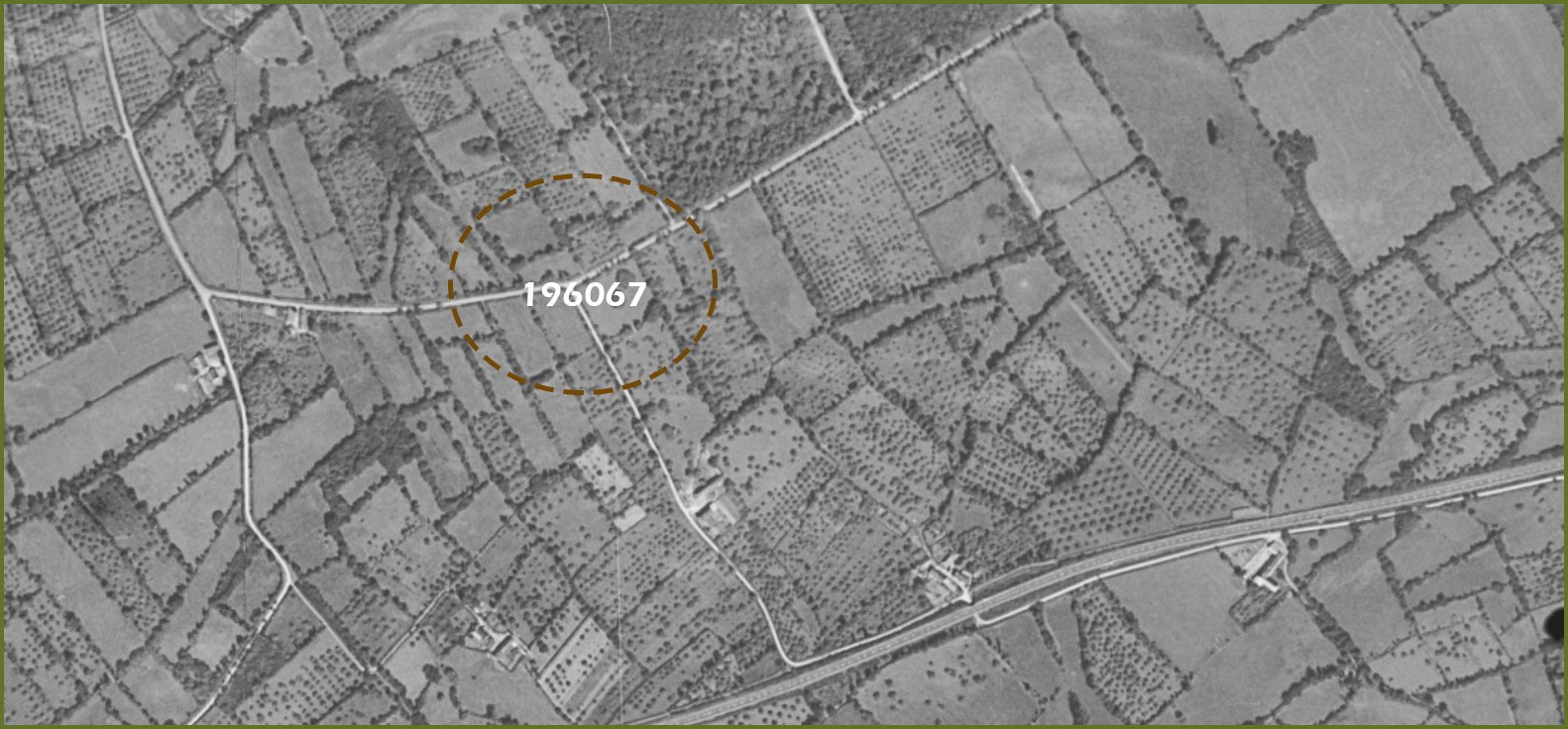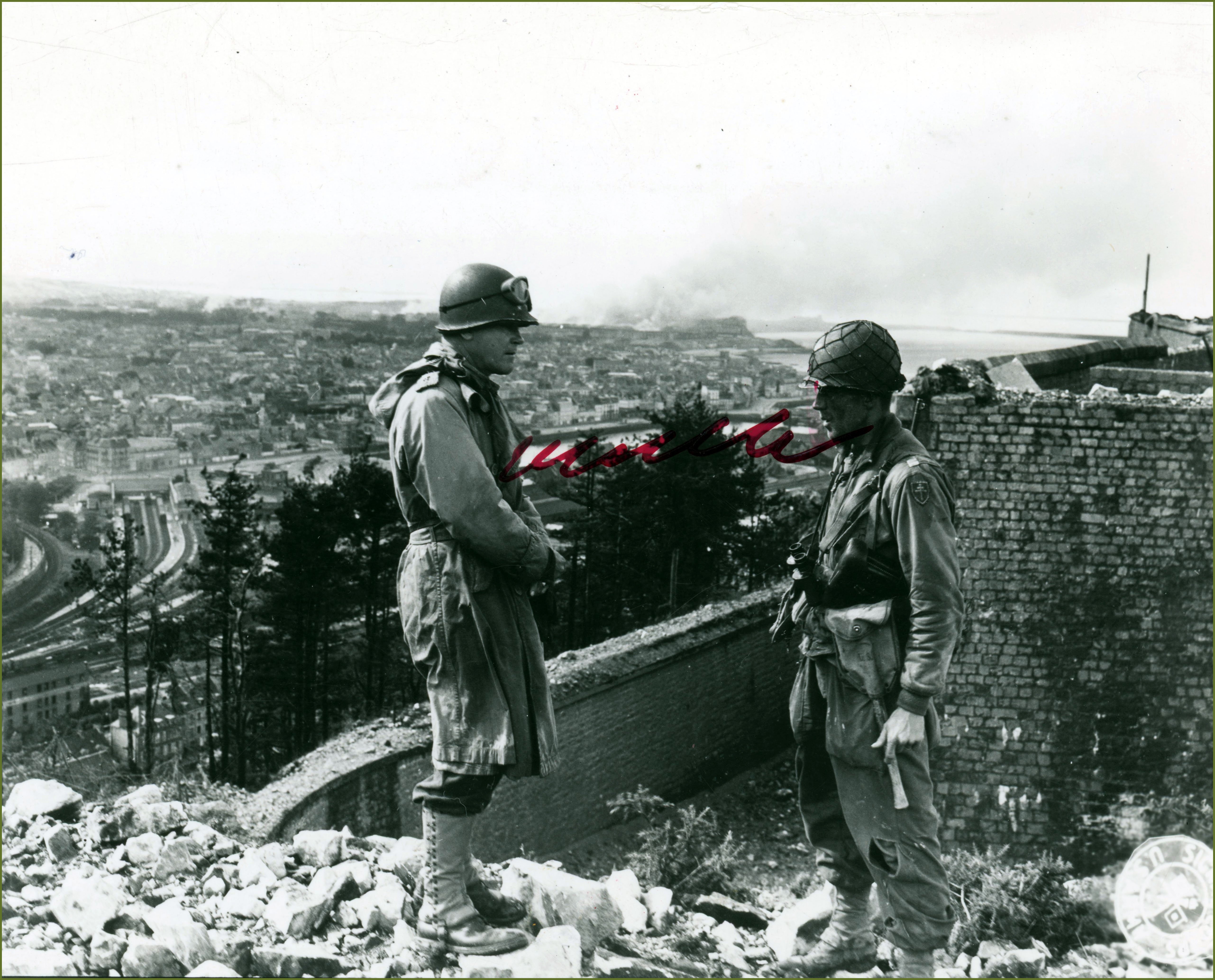The 79th Infantry Division as the other US Infantry Divisions engaged three Infantry Regiments into battle. You have already discovered the story of the 313th Infantry Regiment during the Cherbourg Campaign, now let’s talk about the 314th Infantry Regiment.
Commanding Officers
.jpg?width=326&height=498&name=Robinson%20(1).jpg)
Commanding Officer: Lieutenant-Colonel Warren A. Robinson
- Executive Officer: Lieutenant-Colonel James F. Davis.
- Staff Officers: S-1 Captain Donald W. Talcott - S-2 Major Hermann J. Schulze - S-3 Major H. Hillier - S-4 Major John R. Kurdy.
- 1st Battalion: Lieutenant-Colonel Olin E. Teague.
- 2nd Battalion: Lieutenant-Colonel A. Huff.
- 3rd Battalion: Lieutenant-Colonel Ernest R. Purvis.
Before embarking in this noble undertaking, the 314th Infantry Regiment was stationed near Southampton in scattered staging areas. Soldiers embarked by small units onboard various types of landing crafts and liberty ships.
The first unit of the regiment to land on Utah Beach was the Regimental Headquarters on June 14th at 0930pm. It had left England on the previous day at 0800pm. The rest of the regiment arrived during the following days.
 US soldiers disembarking and marching toward the flooded area.
US soldiers disembarking and marching toward the flooded area.
Once all the men had set up foot on the soil of France, first units to be on the continent moved in the vicinity of crossroads #33 north of Blosville, precisely at coordinates 362934 (see map below).
 ©2023IGNMap.com
©2023IGNMap.com
At midnight on the 16th of June 1944, 1st and 2nd Battalions had joined their assembly area. For the next days the rest of the regiment continued to disembark their vehicles, and equipment.The Cannon Company had closed its assembly area on June 14th at 0800am, the 3rd Battalion on the same day but at 0815pm and finally the Service Company at 1145pm.
Preparing a landing is not an easy task, thousands of men left England onboard various ships, logistic was the heart of this undertaking but sometimes, when thousands of men arrived from the other side of the English Channel on small beaches as the ones in Normandy, landing mistakes can happen. The Antitank Company unloaded not on Utah Beach but inadvertently on Omaha Beach some thirty miles at the west! It was Captain Edward J. Gorecki who informed the Regimental Headquarters of this mistake. The period of concentration was spent to dewater proofing the vehicles, weapons, preparing and checking maps, and preparation for combat.
June 18th, 1944, the 314th Infantry Regiment was ordered to move in the vicinity of Picauville at coordinates 2972943. The first troops to leave the assembly area were gone by 0100pm and by 0615pm all units were in their new assembly area. While the regiment was moving to its new assembly area, Lieutenant-Colonel Robinson was ordered to come to a meeting at the Division Headquarters to take orders. An attack being scheduled on the 19th of June placing the 314th Infantry Regiment in reserve, at the south of Biniville at coordinates 243982.
When Lieutenant-Colonel Robinson came back, he informed the battalion commanders, the staff commanders of the situation, and all of them started to discuss of the plan. How to proceed? Which are our strengths and weaknesses and the ones of the enemy? The Colonel issued an order to move to a new assembly area and by 0430am, on June 19th all troops had moved there. The men were placed on a 2-hour alert at 1200pm, finally at 0700pm an order from Division Headquarters was received, the 314th Infantry Regiment was about to enter into action.
The 2nd Battalion men were loaded on trucks to bring them into position and at 0900pm, they were dropped at crossroads at coordinates 196067(see map below) where they didn’t wait any second before firing their first bullets. Men went into action by launching an attack on the ridge of La Croix Jacob (D-146).
 ©2023IGNMap.com
©2023IGNMap.com
The 1st and 3rd Battalions were driven to their new assembly area. The 1st at coordinates 207070, the 3rd at the north of Négreville while the Regimental CP was set up at coordinates 192056 by 1144pm. Five hours later, at 0415am the 2nd Battalion had reached La Croix Jacob, its CP was established at coordinates 187067.
The 20th of June 1944 marked the first day in which the three battalions went into action together. The 1st Battalion left its assembly area, went north and attacked the German positions, the 3rd Battalion was just behind by passing by the same line of departure. In the early hours of the day, precisely at 0715am, men of the 1st Battalion secured the road junction #57 at coordinates 196083, one hour later, men reached the outskirts of Hameau És Long (N-13). The 3rd Battalion was right behind it.
For their first day in battle all together, three battalions made prisoners of war, captured gun emplacements but also saved some comrades:
- The 1st Battalion captured fourteen prisoners of war, including one Captain, one 88mm gun and eight German tanks.
- The 2nd Battalion rescued four US paratroopers who were dropped too far inland, behind enemy lines and had no choice but to hide in the woods. (Paratroopers had been hiding since D-Day, thirteen days).
- 3rd Battalion captured at 1155am, eight 88mm guns, two antitank guns at coordinates 179112, but their greatest capture was a plane launching station near Brix.
After those actions, the advance continued for the three battalions, 1st Battalion was north of Les Landes along a line coordinates 139154 – 144757, 2nd Battalion moved to an assembly area at coordinates 145148 and 3rd Battalion at its new assembly area coordinates 145148.
From these new positions the 314th Infantry Regiment could see the outer defenses of Fortress Cherbourg (watch the video below). To reconnoiter, active patrols were sent that night and on June 21st. Patrol’s reports taught the regiment that well-fortified positions were ahead of them with guns. The German artillery opened fire on the men of the 2nd Battalion who were in their assembly area causing many casualties, forcing Lieutenant-Colonel Robinson to assemble the officers to talk about the situation on the frontlines and to order every man of the regiment to be on alert.
314th's positions, ahead of them Fortress Cherbourg - ©CombatReels.com
He told them they were under the fire of the main Cherbourg’s defenses, and that an attack was going to take place on the 22nd of June between noon and 0400pm after an air bombardment. All men were ordered to withdraw 1200 yards so as not to be under friendly fire. Vehicles were also withdrawn 500 yards to avoid of being destroyed by German artillery.
The attack of the 22nd of June 1944 was an Infantry typical attack in column of battalions (1st , 3rd and 2nd Battalions) with the objective of taking the high ground at coordinates 140177 to coordinates 150180. Air bombardment started at 0100pm, but bombs fell behind the regiment’s frontlines, worse US planes were machine gunning their comrades! This friendly fire caused casualties among the ranks of the 3rd Battalion, five men were hit and one truck destroyed.
The attack finally jumped off at 0200pm with the men of the 2nd Battalion, “B” Company was running into a fortified area at coordinates 144169 (see map below) while “C” Company was moving into a field at the left through Tollevast.
 ©2023IGNMap.com
©2023IGNMap.com
The German artillery was one of the US soldiers worst nightmare! While “C” Company was fighting in Tollevast, enemy artillery fell on them, disorganizing the company. The 3rd Battalion was working with one battalion of the 313th Infantry Regiment, both of them had the east-west road as objective through the road junction at coordinates 15181.
Additional order was received telling the 1st Battalion to disengage to support the 3rd Battalion, but “A”, “B” and “C” Companies were not able to follow due to the heavy enemy fire. The attack continued on the next day June 23rd, with a new order. The 2nd Battalion was given the mission to clear the inland roads leading the 3rd Battalion by passing through the road junction at coordinates 154151166.
In the meantime, men of the 3rd section of Headquarters Company commanded by Major Henri F. Koch and Captain Theodore M. West silenced out the strongpoints #9 at coordinates 144169.
The 3rd Battalion of the 314th Infantry Regiment launched its attack at 1100 hours, its objective? The german strongpoints #33 precisely at coordinates 153197. “I” Company found itself under the German artillery and was forced to withdraw due to the casualties. The 1st Battalion advanced up to Hill 33 but an air bombardment was scheduled on the 24th of June: all companies of the 1st Battalion, except “A” Company, withdrew.
Each Battalion had a specific objective on the third day of the attack:
- 3rd Battalion was given the mission to continue its attack on strongpoint #33 from the southwest.
- 2nd Battalion was to attack strongpoint #34 at coordinates 157195 from the southeast
- 1st Battalion was in the Regimental Reserve and thus followed the leading battalion.
The air Bombardment began at 0800am, men went into action twenty minutes later. This attack was a huge success, 2nd and 3rd Battalions succeeded in taking their objective approximately one hour and half later: strongpoint #33 fell at 1000am and strongpoint #34 at 0943am.
Men of the 314th moving into Cherbourg - ©CombatReels.com
Then things got worst! As the troops were not far away from Cherbourg, the 3rd Battalion tried three times to seize the high ground outside of Fort du Roule, constant machine gun, and artillery fire made the action impossible.
At 1100pm Major Hillier went toward the 2nd Battalion's commander telling him how the attack was to take place.
Plan of attack to take Fort du Roule
2nd Battalion will advance to the north to point N°46 at 0830am, just after an air bombardment scheduled at 0800am. Once the men reached point N°46, they will have to advance to the ridge and take Fort du Roule. The battalion will be assisted by the 3rd Battalion by firing from its ground positions. The 1st Battalion will follow the 2nd on the right rear.
 Aerial view of Fort du Roule after the battle.
Aerial view of Fort du Roule after the battle.
The order for the final attack was received at 1005pm in the evening of June 24th. It's for tomorrow, tomorrow will be the beginning of the end of the German oppression on the city. On the 25th of June 1944, the 2nd Battalion captured point N°46 at 1000am, thus one hour and half after it had left its line of departure.
“F” Company captured the lower position of the fort finding a motor pool and a large amount of enemy material, then started to walk toward Fort du Roule. In the meantime, “E” Company in conjunction with “F” Company was ordered to attack Fort du Roule.
At 1145am, a German came out from his dug-in emplacement waving a white flag, making possible the capture of around one-hundred and five prisoners of war in the lower part of the fort (watch the video below). Men were frustrated, despite the taking of hundreds prisoners they were not able to continue their attack due to the heavy fire from higher machine gun nests and from the valley. As enemy fire was also coming from the valley, the 3rd Battalion received the order to silenced all German positions which could prevent the 2nd Battalion to seize Fort du Roule.
German prisoners coming out from their dug-in emplacement under Fort du Roule - ©CombatReels.com
The 2nd Battalion tried all day to seize the fort without success, it will be only at 1248am on the 26th of June 1944, when white flags appeared to windows, that the remaining Germans abandoned the fort in the American hands. During the night the battalion, after a day of hard fighting, bivouacked on top of the fort (watch the video below).
Men of the 314th Infantry Regiment on the top of Fort du Roule - ©CombatReels.com
The 1st Battalion succeeded in taking its objective, and worked patrols into the outskirts of Cherbourg while the 3rd Battalion was sent off into assembly area. The taking of Fort du Roule was only the first step to the fall of Fortress Cherbourg! Indeed, the 9th Infantry Division attacked Cherbourg by the west and the 4th Infantry Division from the east.
 Major General Joseph Lawton Collins and Captain Robert Kirkpatrick on the heights of Fort du Roule.
Major General Joseph Lawton Collins and Captain Robert Kirkpatrick on the heights of Fort du Roule.
In the early hours of what was the last day of the German presence in Cherbourg, the 1st and 3rd Battalions attacked directly through the central part of the city. The 2nd Battalion was given the mission to defend Fort du Roule, points N° 45 and 46 but also to silence the guns which were on the lower position of the fort. Germans dug-in tunnels (see photo below) and set up four guns in the mountain, from that position enemy gunners were able to defend the harbor.
 Entrance of the tunnels below Fort du Roule with four gun emplacements dug-in by the Germans in 1942.
Entrance of the tunnels below Fort du Roule with four gun emplacements dug-in by the Germans in 1942.
It will be only by the end of the afternoon, after several hours of street fighting, at 0530pm that the harbor area, which was the regimental objective, was freed. But the mission was not finished for all of them, the 2nd Battalion was still attacking the guns on the lower positions of the fort and so until 0700pm.
Note: Normandy American Heroes guests have the privilege to visit the underground tunnels of Fort du Roule!
 Underground tunnels, below the fort.
Underground tunnels, below the fort.
Altogether, around five-hundred prisoners of war were taken at Fort du Roule. On the 27th of June 1944, the 314th Infantry Regiment made contact with the 4th Infantry Division which took over the prisoners of war made by the regiment.
After the Cherbourg Campaign, the 314th Infantry Regiment moved to a new assembly area South of Bricquebec (D-902).
Fort du Roule and a Medal of Honor Recipient

His actions will be reviewed and he will be then posthumously recipient of the Medal of Honor, in January 1945.
"After working their way through the barbwire obstructions, one of the platoons from Co. E became pinned down by one of the machine-gun bunkers. Corporal John Kelly volunteered to attack it with a pole charge. He approached the bunker under heavy fire, but the charge failed to silence the bunker, which was protected with a steel plate in the embrasure. He returned for a second charge, which damaged the machine-gun barrels of the embrasure. He returned for a third charge, which did enough damage to make the bunker vulnerable to grenade attack. After hurling grenades inside, the surviving German crew surrendered".
Written by Pierre Fallet - Normandy American Heroes

















